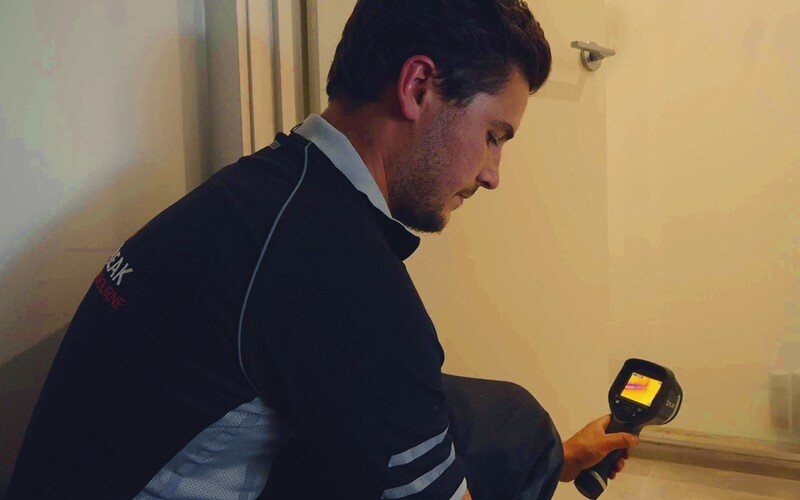Overview To Water Leakage Detection In Your Home
Overview To Water Leakage Detection In Your Home
Blog Article
Do you find yourself hunting for selective information about Detecting hidden plumbing leaks?

Early detection of leaking water lines can mitigate a possible calamity. Some tiny water leakages may not be noticeable.
1. Take A Look At the Water Meter
Every residence has a water meter. Checking it is a proven way that assists you find leaks. For starters, shut off all the water sources. Make certain nobody will certainly flush, utilize the faucet, shower, run the washing equipment or dishwashing machine. From there, most likely to the meter and watch if it will certainly transform. Since nobody is using it, there must be no motions. If it relocates, that indicates a fast-moving leak. If you identify no changes, wait an hour or 2 as well as check back once more. This means you may have a sluggish leak that could also be underground.
2. Inspect Water Intake
Analyze your water bills and track your water consumption. As the one paying it, you must discover if there are any type of disparities. If you find sudden changes, regardless of your consumption coinciding, it suggests that you have leakages in your plumbing system. Bear in mind, your water costs ought to fall under the exact same array on a monthly basis. An unexpected spike in your expense suggests a fast-moving leakage.
A consistent increase every month, even with the exact same practices, shows you have a slow-moving leak that's additionally gradually escalating. Call a plumber to completely examine your residential property, particularly if you feel a cozy area on your flooring with piping beneath.
3. Do a Food Coloring Examination
When it comes to water usage, 30% comes from bathrooms. If the color somehow infiltrates your dish throughout that time without flushing, there's a leak between the container and dish.
4. Asses Exterior Lines
Don't fail to remember to check your exterior water lines as well. Should water leak out of the link, you have a loose rubber gasket. One small leak can lose loads of water and increase your water expense.
5. Evaluate and Analyze the Scenario
Home owners must make it a routine to inspect under the sink counters as well as even inside cabinets for any bad odor or mold and mildew development. These 2 red flags suggest a leak so timely interest is needed. Doing routine evaluations, also bi-annually, can conserve you from a significant problem.
Much more notably, if you recognize your house is already old, maintain a watchful eye on your heating systems, hose pipes, pipelines and so on. Look for discolorations as well as damaging as the majority of pipes and devices have a life expectancy. They will likewise normally deteriorate as a result of tear and also use. If you believe leaking water lines in your plumbing system, do not wait on it to rise. Call a professional plumber today so you do not end up with an awful mess in your house.
Early detection of leaking water lines can alleviate a potential calamity. Some small water leakages might not be noticeable. Inspecting it is a surefire means that aids you find leakages. One small leak can lose lots of water as well as surge your water bill.
If you suspect dripping water lines in your plumbing system, do not wait for it to intensify.
How to Know If Your Home Has a Hidden Leak
Water Meter Reveals Inexplicable Water Usage
If you’d like to test whether or not there’s a leak somewhere in your home, you can do this using your water meter. Here is how to conduct the test:
Don’t use any water in your home for at least 30 minutes; this also means not turning on faucets or water-using appliances.
Go outside, and check your water meter for activity.
If your water meter shows that there was activity, even though no one was using any water, this proves that there is a leak in your home.Visible Mold or Mildew Growth
Leaks behind walls create moist, dark environments that allow mold and mildew to grow and thrive. Eventually, you might see mold growth forming on the wall closest to a hidden leak.
If mold is growing in an area that receives a high amount of moisture, such as a bathroom, it may simply be an indication that better ventilation is needed. However, if you see mold growth on a wall or the ceiling in an area where you would not expect, you probably have a hidden leak.
Musty, Mildew Odor
Sometimes you might not be able to see the mold or mildew that is growing as a result of a leak. However, the smell can give the problem away just as easily. If you catch a whiff of something musty, there’s a good chance that old water is collecting somewhere in your home that you can’t see.
Stained/Warped Walls, Ceilings, or Floors
When your home soaks up water, a variety of red flags can become visible, including ceiling stains, bubbling drywall, warped walls, and sagging floors. While these issues can be caused by excess humidity, they can also be signs that a pipe or plumbing connection has started leaking behind your walls.
Inexplicably High Water Bill
After a while, you get a general sense for what your water bill should be. If you own a pool or sprinkler system, your bill will tend to be higher during summer. However, if you receive a water bill that seems especially high, and you can’t figure out what caused it, then you may have a hidden leak somewhere that’s increasing your bill.
https://www.plumbingjoint.com/blog/2019/july/how-to-know-if-your-home-has-a-hidden-leak/

We had been made aware of that editorial on Top leak detection hacks from someone on another domain. Don't hesitate to take the time to promote this blog post if you enjoyed it. I truly appreciate reading our article about Locating water leaks.
Report this page